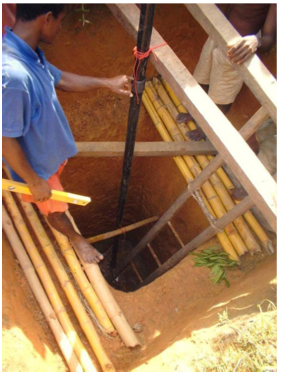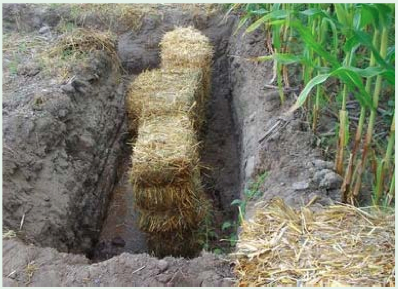Water Portal / Rainwater Harvesting / Groundwater recharge / Infiltration wells
| |
|
|
|
|
|
|
|
|
Also called interception wells, infiltration wells are shallow wells which put (or draw) water into (or from) a natural aquifer outside of a riverbed, but which have a partial lining. They can be used to either drain a catchment area or recharge groundwater, especially where recharge of the aquifer is low due to low rock/soil permeability (the well penetrates through this). Water extraction, however, is a secondary activity, as the water levels will be lower and the amount extracted will be more limited.
Infiltration wells do not have to have a direct inlet (although they can have one). Without an inlet, they can become a larger hole and be filled with porous natural materials to increase the ground's infiltration capacity and, in most cases, have a coiled drain between the soil surface and the underground piping. This coiled drain is perforated to allow water inside where it can flow more quickly out of the drain. It acts as a security for high rainstorm runoff events that might rain too much water to effectively infiltrate into the well or aquifer.
Rocks, coarse wood chips or straw can be used as filtering material. Wells made of straw are constructed like permeable trenches and do not have a coiled drain, which can limit their infiltration capacity. Water extraction can be done with Handpumps or Small and efficient motor pumps. Handpump cylinders will need to physically be able to fit inside the screen that has been installed.
Suitable conditions
- Site where water table is within 5 metres of ground surface, and where soils are stable.
- Site where water demand is low, e.g. for small communities.
- Do not install in areas where water drainage is rapid. Since infiltration wells have a low infiltration capacity, the drainage rate will be insufficient and will not make it possible to reduce the risk of erosion.
Avoid contamination
Site wells at a sufficient distance away from sources of contamination. For microbiological contamination, the distance from the source of contamination (e.g. latrine) to the water intake (screen) needs to be sufficient so as to pose a “low” to “very low” risk – this translates into a minimum of 25 days of potential travel of pathogens in the ground. Travel time is influenced by porosity, hydraulic conductivity (permeability), and hydraulic gradient.
For medium size sand with an average porosity, the distance equivalent to 25 days is around 30 metres, but this can increase to over 100 metres for coarser sediments. However, the distance from contamination to water intake can reduce significantly where the screen intake is at a sufficient depth – this is due to greater variation of aquifer properties in vertical directions than lateral, meaning that a borehole with handpump could be placed very close to a latrine with low risk. However, screen depth must increase with increased extraction rate.
| Advantages | Disadvantages |
|---|---|
| - Lower cost than making a fully lined well due to less lining needed - Speedier construction compared to fully lined well |
- Not much water is available for extraction (as compared with a traditional well)
- Cannot easily access intake for maintenance or in case of problems |
Resilience to changes in the environment
Drought
Effects of drought: Less recharge of aquifer due to less rainfall; Increasing population & water demand; Size of aquifers – e.g. limited sand volume; Wells not sunk deep enough into water table; Incorrect siting; Graded gravel around pipe not correctly done.
Underlying causes of effects: Less recharge of aquifer due to less rainfall; Increasing population & water demand; Size of aquifers – e.g. limited sand volume; Wells not sunk deep enough into water table; Incorrect siting; Graded gravel around pipe not correctly done.
To increase resiliency of WASH system: Increase volume through construction of groundwater dam; Sink wells/pipes deeper; De-water wells during caissoning within the water table; Construct during the latter half of the dry season; Site in riverbeds that are dry for part of the year, where water remains in the riverbed throughout the dry season; Increase flow by use of porous concrete & perforated pointed steel pipes driven horizontally into the aquifer (riverbed wells) and graded gravel (infiltration galleries & jetted wells); Site in a degrading river section where there is no deposition (infiltration galleries); Put graded gravel around pipes to minimize clogging and increase flow.
More information on managing drought: Resilient WASH systems in drought-prone areas.
Construction, operations and maintenance
General advice on cement: A common cause of cracks in structures and linings (e.g. in tanks, dams, waterways, wells) is errors in mixing and applying the cement. First of all, it is important that only pure ingredients are used: clean water, clean sand, clean rocks. The materials have to be mixed very thoroughly. Secondly, the amount of water during mixing needs to minimal: the concrete or cement needs to be just workable, on the dry side even, and not fluid. Thirdly, it is essential that during curing the cement or concrete is kept moist at all times, for at least a week. Structures should be covered with plastic, large leaves or other materials during the curing period, and kept wet regularly.
Construction
- Construction involves digging a hole to the water table in stable soil that has no risk of collapsing. Digging should not go deeper than 5 metres for safety reasons.
- Digging continues inside the water table but due to the low yield of the aquifer, digging can proceed only without buckets for de-watering purposes.
- An intake needs to be created which will be installed in the well before backfilling. The intake can normally be a screen that is connected to casing – this should be large enough in diameter to fit the handpump cylinder. The intake can be installed in several ways:
- A chamber can be constructed within the water table zone from suitable material (e.g. blocks) and covered with a slab – the intake pipe is placed through the slab, after which the hole can be backfilled to ground level, adding more sections to the intake section as required.
- A cheaper way is to install the intake in the empty hole. Verticality is ensured using a spirit level, after which the intake is secured temporarily to beams at ground level. The hole is then backfilled with clay-free sand to the height of the wet season water table level, after which the hole is backfilled with original soil. In this way, an artificial aquifer is created around the intake and well volume is equivalent to the porosity of the sand.
- A pump can then be installed within the intake screen.
- Where wells dry up in the dry season, recharge techniques could be used upstream of the well.
Rock or wood chip infiltration wells

A hole measuring 1 to 1.5 m in diameter and approximately 1 m deep is excavated at the location selected for the infiltration well. If the well is constructed with rock in sandy or loamy soil, the bottom and sides of the excavation can be covered with a geotextile membrane (of the Texel 7609 or 7612 type). This membrane will prevent lateral clogging by the rock and is attached to the drain with drainage adhesive tape where the drain crosses it. The membrane is cut 30 cm below the surface of the soil if the soil is to be tilled above the well once installation is complete. Otherwise, the membrane can extend up to the soil surface. Note that no geotextile membrane is used in wood-chip wells.
The excavation is progressively backfilled with the desired material. The drain is coiled in the porous material as it is placed in the hole. In wells made of rock, it is recommended that backfilling begin with clean 56-mm rock, although finer stone (such as 19-mm stone) can also be used.
The drain is cut at the desired height, and a cap is placed at the end. If the soil is to be tilled above the wells after the work is complete, the coiled piping must stop at least 30 cm below the ground surface so that the piping is not damaged by tilling equipment. The backfilling of the rock well is completed with materials that will not damage the tilling equipment (coarse soil if available, coarse sand, wood chips or clean 19-mm stone). Laying a geotextile membrane between these two zones is not recommended, because it would quickly be clogged by the silt contained in the surface runoff. Wood-chip wells are generally fully backfilled with wood chips.
Where the erosion rate is high and the risk of clogging is significant, it is preferable that the soil above the infiltration well not be tilled. A minimum radius of 3 m around the well is therefore grassed over to filter the soil particles and create a buffer zone between the tilled soil and the infiltration well. The well can also be covered with rock (e.g. clean 100- mm rock) to finalize the installation.
Permeability of some types of rock (meters/day)
| Type of rock | Permeability
(m/d) |
|---|---|
| gravel | 100 - 1000 |
| mixed sand and gravel | 50 - 100 |
| coarse sand | 20 - 100 |
| fine sand | 1 - 5 |
| fractured or weathered rock | 0 - 30 |
| sandstone | 0.1 - 1.0 |
| clay | 0.01 - 0.05 |
| shale | negligible |
| limestone | negligible |
| solid rock | negligible |
Maintenance
Generally, it is recommended that minimum tillage practices be adopted to maximize the lifespan of the well. If a well gets clogged, the first 30 cm of the porous material is replaced to improve the infiltration capacity.
Organic filtering materials decompose gradually over time. Because of better oxygenation conditions near the ground surface, decomposition is faster in the upper part of the well. In wood-chip wells, it is generally necessary to add more wood chips every 10 years to compensate for subsidence caused by the decomposition of the material in place. Given its lower carbon/nitrogen ratio and high cellulose content, straw decomposes much faster and must be replaced more frequently. Coarse sand can also be used to replace decomposed material in both cases. Lastly, infiltration wells and separate drain outlets must be inspected frequently to evaluate the condition of the structures as well as their efficiency in improving surface drainage and reducing erosion problems.
Manuals, videos and links
- Well revival effort sees many other benefits A community drive to revive wells in Mokhla talab near Udaipur results in water security for longer periods of time as well as making leaders out of women.
- Experiments with 'community wells' Mobilized farmers in Dhule, Maharashtra, show how communities can use groundwater as a common resource in an organised and collective manner.
- Infiltration wells Factsheet. Agriculture and Agri-Food Canada (AAFC) and the Ministère de l’Agriculture, des Pêcheries et de l’Alimentation du Québec (MAPAQ).
- ARTIFICIAL GROUNDWATER RECHARGE FOR WATER SUPPLY OF MEDIUM-SIZE COMMUNITIES IN DEVELOPING COUNTRIES. E.H. Hofkes and J.T. Visscher. December, 1986.
Acknowledgements
- CARE Nederland, Desk Study: Resilient WASH systems in drought-prone areas. October 2010.
- Infiltration wells Factsheet. Agriculture and Agri-Food Canada (AAFC) and the Ministère de l’Agriculture, des Pêcheries et de l’Alimentation du Québec (MAPAQ).



